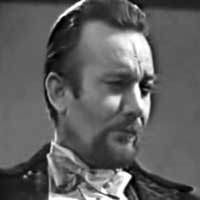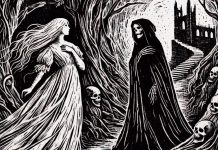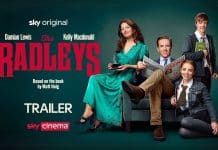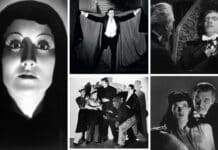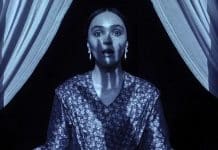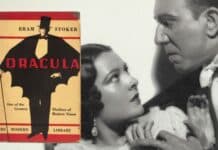CHARLES BUTLER looks back on the Dracula episode from the 1960s Mystery and Imagination UK TV series
Based on the novel by Bram Stoker, written by Charles Graham and directed by Patrick Drumgoole, this TV adaptation stars Denholm Elliott as Dracula, James Maxwell as Dr Seward, Susan George as Lucy Weston, Corin Redgrave as Harker, Suzanne Neve as Mina Harker with Bernard Archard as Professor Van Helsing and Joan Hickson as Mrs Weston.
I was first drawn to the eerie and mostly obligatory violin soundtrack that accompanied shows of this kind. Some of the production values betrayed the low budget and the acting is hampered by thespians who have the added discomfort of filming live.
Bearded and first seen wearing fetching sunglasses, Denholm Elliott as The Count, battles bravely to try and diminish the Christopher Lee image that was doing incredible business at the cinema for Hammer films in Dracula Has Risen From the Grave.
He is musical and works on his conquests by mesmerising them with his incredible knack of tickling the ivories at tea parties – although it is never explained why or how he was invited as a guest. When left alone with the young Lucy, he goes into a maniacal rant as he recounts – very in-depth – Stoker’s history of Vlad Tepes and claims ancestry to Atilla the Hun himself.
He has purchased Glebe House, as opposed to Carfax in this version, but has left the place gathering cobwebs while he catches his forty winks in the coffin of a suicide as the ground is considered to be non-consecrated.
There is no mention that he has to sleep on his native soil, but he must return to the grave before sunrise. In flashbacks, we see him rescue Harker from the clutches of some very un-fetching vampire carrion in his castle. He states that he is from ‘the whirlpool of Europe’ known as Transylvania and relates his campaigns to a wild-eyed Lucy while lecherously taking stock of her ample young cleavage. As with all the best stories on the subject, this Count’s motives are so ambiguous as to be even more so as he just simply parades around offering eternal life and undreamed of knowledge; not to mention power over all the Demons of Darkness.
His vampire attacks are probably the most kinky ever to be put on film for a vampire up to that point. He whirls around the room as a tatty-looking bat omitting the obligatory chittering noises. Appearing from nowhere as himself, he narrows his eyes and creeps towards his victim’s beds, going on his knees for the oral seduction as he takes their writhing forms in his hands to steady them before he sinks his teeth in with a darting thrust. After the penetration, he kisses the wound for a very long time, resisting the urge to suck; and the camera pans to his victim’s face who breaths and moans euphorically for long lingering moments!
Not displaying any overt physical strength, after his unexpected rant about his violent past histories, dampened his character for me, and I was totally let down, as, cornered by the sun and the cross-waving heroes, he turned into your very own garden-variety coward pleading for his life. All in all the character he puts forth, robbed of his savagery, possibly through restriction of censorship, becomes quickly unmemorable. His manufactured melt-down seeming to become an added necessity in both terms of his destruction and to add wild-eyed awe. A large step out of character for the distinguished actor, from fidgeting unkempt rakes to Transylvania’s own aristocratic celebrity, Mr Elliott’s restricted performance unfortunately misfires on many Counts.
The supporting cast includes Bernard Archard’s Professor Van Helsing as a believable medical practitioner who takes notes and uses mesmerism on his patients to find knowledge of their past whilst giving one of the more believable accounts of the rise of vampirism across the Globe. The jealous Dr Seward played by James Masters is possibly the most closed mind of all the previous and ongoing Sewards. He lets his love for Lucy blind him to the very real horrors that abound and constantly shouts down the Professor’s theories of vampires and goblins. When Lucy succumbs to the undead villain, Seward is prepared to physically beat a confession out of the ailing mother played by TV’s Miss Marple supremo, Joan Hickson. Her eminence in the thesping stakes gives Mrs Weston more screen time than any other parent in the canon of Dracula movies and also rescues her from suffering the heart attack of her predecessors. She becomes a whining and interfering busybody who seals her own daughters fate at the Count’s hands and then nonchalantly retires to her own rooms in anticipation of her next tea party.
Corin Redgrave’s Jonathon Harker is given the indignity of taking on the Renfield persona in this version. Opening the film with an escape from his cell and throwing himself at the aristocratic stranger, fingering him as his master in front of a bewildered cast. But the young lawyers nights are filled with dreams of this urbane European as he is rescued from three grinning, salivating and (oddly) hopping hags who don’t show fangs but bare some of the most startling denture work in the history of the Dracula movie. In conversation, it is noted that Harker and Dracula boarded the Demeter to return to England, but Dracula has another ace up his sleeve, the fact that he lies constantly through the side of his face, leaving everyone even more confused.
Eventually, the patient who is referred to as number 34 is unmasked as Jonathon Harker when family friend Mina appears on the scene – were none of them invited to the wedding as no one seems to recognise her husband? He is mesmerised by Van Helsing and learns of the poor man’s ordeals at the Castle. In a surprising, but downbeat, moment, Dracula takes control of Harker and speaks through his lips to the wide-eyed hunters, proclaiming the hopelessness of their situation. Harker then goes on to lure Mina to the Count’s rendezvous where she is bitten by a transformed Lucy Weston.
Susan George plays Lucy, taken in by the Count’s piano playing and his unusual chat up lines – mainly his talk of victories across the centuries. Ms George displays a sexuality that made her famous in later films like Sam Pekinpah’s Straw Dogs (1974) as Dracula makes his advances, but she is underused as the wandering wraith, even though she gets more screen time than many of her predecessors. Her death sequence could have been the most notorious ever put on film, but is undercut by the jittery camera work and the technicalities of filming live.
Mina Harker (Suzanne Neve) is already married to Jonathon and the TV budget is able to restrict the action to the Seward household.
She unmasks patient 34 as her husband in front of the open-mouthed wedding guests, and then forgets her concern for him as the Count turns his attentions on her.
Well acted, but very confusing in it’s execution. Charles Graham’s screenplay tries for originality in a story that would be run into the ground by the mid nineteen seventies.
Television would have to wait almost 10 more years for a definitive version of the tale in Gerald savoury’s BBC drama Count Dracula (1978) with Louis Jourdan.
CHARLES E. BUTLER is the author of The Romance of Dracula and the newly-released Vampires Everywhere: The Rise of the Movie UnDead. Read our Spooky Isles interview with Charles Butler here.


